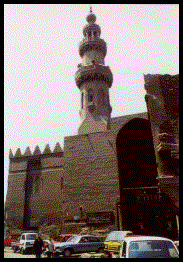Prospective Study 2: El-Merdani Mosque,
Cairo, Egypt
|
|
Prepared by: Aachen Univ. of Technology |
conclusions
El-Merdani
Mosque in Cairo was selected for investigation within the frame of the
Prospective Study 2 (PS2) for reasons of its historical importance,
characteristic stone materials and considerable stone damages.
El-Merdani
Mosque was built in the XIV century as one of the finest examples of Islamic
architecture in Cairo. Porous limestones from quarries near Cairo were used for
construction. These limestones represent the main construction material of
monuments in historical Cairo. The type of porous limestone has been used in
construction of numerous historical monuments in the whole Mediterranean area.
Bad
condition of El-Merdani Mosque was started at the end of the XIX century.
Restoration works like reconstruction, structural reinforcement and renovation
of walls, were carried out in the period 1896-1903 by the Arab Antiquities
Conservation Committee. Today, El-Merdani Mosque is again in need of
intervention. Especially, damages at the lower parts of the monuments are
striking. This concerns walls at the outer façades and walls in the interior of
the monument in the same way. Comparable situation can be found at many other
monuments in historical Cairo. Thus, the PS2 studies at the selected pilot
monument have contributed to assess a very characteristic damage situation at
ashlar monuments in the center of Cairo.
Interdisciplinary
studies on stone degradation due to weathering at the mosque were carried out
by the project partners from Egypt, Germany and France by means of joint
application of modern, complementary in situ methods and analytical
procedures in laboratory. In situ investigations were executed in the
frame of three field campaigns of the project partners. Ins situ
investigations and laboratory analyses were aimed at characterization of stone
materials and at characterization and quantification of weathering forms,
weathering products and weathering profiles which jointly characterize the
state of degradation due to weathering and which provide information on
weathering factors and weathering processes. Subsurface conditions at
El-Merdani Mosque were studied and considered additionally in order of
comprehensive damage diagnosis.
The studies
on stone materials have shown a significant variation of petrographic and
mechanical properties. The results reveal, that the type of porous limestones
used in historical Cairo since ancient times until today comprises a
considerable number of very different subtypes. The results obtained from the
PS2 studies mean an important contribution to assessment of the range of
limestones at monuments in Cairo and in nearby quarries and they have improved
awareness of this important objective from scientific sand practical point of
view regarding differentiated characterization, interpretation and rating of
stone degradation and quality management of monument preservation measures.
Continuation of systematic survey and analysis of limestones in Cairo is
recommended.
Monument
mapping was applied as a well-experienced and internationally accepted
non-destructive method for precise registration, documentation and evaluation
of weathering forms, which represent phenomenological results of weathering
processes. As basis for monument mapping, a detained classification scheme of
weathering forms was worked out, tailored to objective and reproducible
applicability at all Cairo historical ashlar monuments constructed with limestones.
Damage categories and damage indices were established as practical tools for
quantitative rating of damages at these Cairo historical monuments. a
correlation scheme "weathering forms — damaged categories" was developed in the
frame of PS2 for all historical limestone monuments in historical Cairo. The
consequent approach "weathering forms — damage categories — damage indices" was applied in the frame
of PS2 at an Egyptian monument for the first time. This approach can now be
transferred to all Cairo historical monuments constructed with limestones.
Well-directed
in situ measuring procedures and laboratory analysis by means of modern
analytical procedures have provided important additional quantitative
information on state of degradation, especially as concerns weathering profiles
and weathering products. numeric structure-modeling analysis was applied as
modern tool for assessment of structural stability.
The
interdisciplinary co-operation and the consistent methodological concept have
guaranteed information on all scales of stone degradation ranging from
nanoscale (<mm) to microscale (mm to cm), mesoscale (cm to m) and macroscale
(façades, entire monument).
For the
studied lower parts of El-Merdani Mosque remarkable damages were stated. The
damages are characterized by:
-
loss
of stone material - recession of
the stone surface amounts to 10 cm at maximum;
-
recent
detachment of stone material - many different types, often high intensities,
-
deposits
- soiling end especially salt
deposits in form of efflorescences / subflorescences and salt crusts,
-
structural
discontinuities/instabilities - fissures, break out, displacements.
Results of in
situ measurements and laboratory analyses confirmed considerable stone
degradation, i.e. textural weakness of the stone material and loss of
cohesion in the surface zone of the walls. For all three-investigation areas
high proportion of severe or even very severe damages were stated. The
calculated damage indices quantify and advanced state of stone degradation and
indicate need of intervention.
The results
obtained fro El-Merdani Mosque reveal a significant example of weathering
damages at limestones due to salt weathering. Different sources of the salts
can be distinguished:
- Increase of air pollution in
Cairo as consequence of the rapid expansion of the city has increased
significantly. This results in deposition of pollutants from the
atmosphere at the stone surface of monuments with subsequent salt
formation, especially gypsum, on the stone surface or in the pore space of
the limestones near to the surface.
- The water table (ground water,
subsoil water) has significantly risen during the last decades. It can be
observed, that in extreme cases the water table has reached the ground
floor of monuments. Insufficient or defect sewage systems have caused
increasingly pollution of the water. Salt solutions from subsurface
intrude into the walls of the monuments and salts are precipitated,
especially halite, on the stone surface or in the pore space of the
limestones near to the surface.
- Lime mortar and plaster — the latter especially used at
the walls in the interior of the mosque — must be considered as further sources of
salts.
